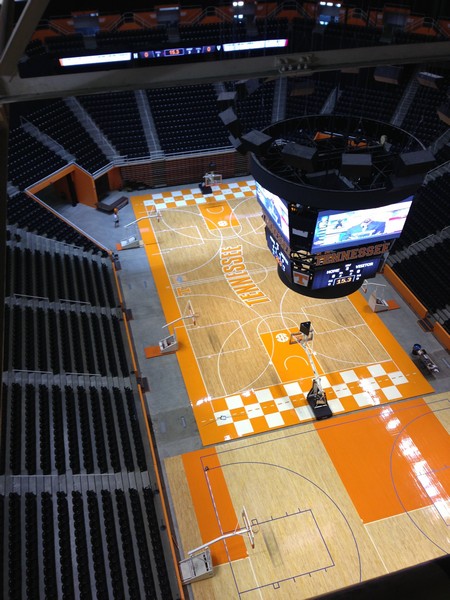With the installation of LED fixtures, the University of Tennessee, Knoxville's, Thompson-Boling Arena is one of the first in the world to feature lights that are smaller, brighter and up to 85 percent more efficient than conventional arena metal halide lights.
The technology—developed and manufactured by Oak Ridge-based LED North America at the Tech 20/20 incubator facility in Oak Ridge, incorporating an Oak Ridge National Laboratory technology, and installed by Knoxville-based Bandit Lites—is being "premiered" at the state's research university inside the largest on-campus single-sport arena in the country.
 |
|
SuperSport installation at UT's Thompson-Boling Arena. (Photo Courtesy of LED North America) |
The LED fixtures use an ORNL-developed lightweight graphite foam that cools the LED, making them more efficient and reliable. This enables 90 400-watt LED fixtures to bathe the arena's floor with 200 foot-candles per square foot, compared to the 130 foot-candles produced by the arena's existing 110 1,100-watt fixtures.
LED North America's SuperSport luminaires have the potential to revolutionize sports and entertainment venues worldwide. UT officials are looking forward to participating in this effort and to seeing the results—and the savings.
"We are happy to be a partner in this venture and to work with the lab and local business on an energy initiative that could impact facilities across the world," said Jeff Maples, Senior Vice Chancellor for Finance and Administration.
The installation of the lights, guaranteed to meet the NCAA, NBA and NHL foot-candle requirement, was completed last week.
"The success of these lights will be a game changer," said Andrew Wilhelm, president of LED North America. "UT is positioned to start a trend that could spread to arenas everywhere in a few years."
UT was a test site for the lights at no cost to the university. The lights, which can be dimmed and brought to full intensity in seconds, were installed on a small scale for testing during UT's summer sports camps. The light quality was measurably superior and will also allow Thompson-Boling Arena to meet the new high-definition television broadcast standard.
Bandit Lites is installing the lights, which will be mounted under the catwalk without affecting the current game lights, allowing for operational and performance testing during the basketball season.
While LEDs produce a tremendous amount of light despite their compact size, they generate considerable heat and are prone to failure if not adequately cooled. ORNL's graphite foam, which is more conductive than aluminum and one-fifth the weight, provides a solution by almost instantaneously pulling heat from the lights.
The graphite foam technology has allowed LED North America to eliminate the traditional heavy aluminum heat sink and produce the SuperSport luminaire, which weighs 22 pounds. By comparison, other arena fixtures weigh more than 100 pounds.
In addition to its light weight and greater efficiency, the SuperSport luminaire has a built-in microprocessor to control individual lights. This allows arena lighting operators to simply click an icon on a tablet to instantly switch to various presets to accommodate basketball, volleyball, concerts and other activities.
LED North America lights similar to the SuperSport are already being used at a facility that handles logistics for Nissan as well as at other indoor commercial warehouse buildings.
LED North America, founded in 2008, is located in the Tech 20/20 building, an incubator facility for ORNL with an objective to create and accelerate the development of high-growth potential companies and jobs by capitalizing on the region's unique technology resources. To learn more about LED North America, visit http://www.led-na.com. UT-Battelle manages ORNL for the Department of Energy's Office of Science.





 CN
TW
EN
CN
TW
EN






